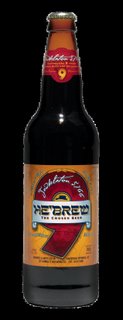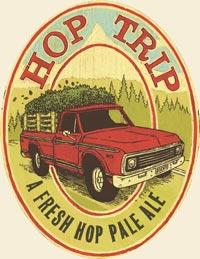He'Brew Jewbelation 5766

I heard about this beer in 2004 (In its 8th incarnation) but didn’t have any luck finding it. When this year rolled around and I had a chance to go to Arizona on Intel’s dime during the Hanukah season, I knew I had to find it. However, this particular bottle was purchased at Bottleworks in Sattle.
Stats:
Brewery – Shmaltz Brewing Company in San Francisco, CA
Style – American Brown Ale
ABV – 9%Malt – 9 types: specialty 2-row, dark crystal, chocolate, victory, munich, carapils, wheat, oatmeal, rye
Hops – 9 types: warrior, northern brewer, Mt. hood, centennial, cascade, vanguard, tettnang, czech saaz, willamette
Serving Type – 22 oz. (bomber) bottle
I can't stop laughing at “He’Brew: The Chosen Beer”. That is some kick-ass marketing right there. This is my first Hanukah beer, and boy is it Jewish. According to the website their "...products are kosher certified to the strictest Orthodox standards by Kosher Supervision of America..." Anyway, as I’m sure you are all aware March 2005 to March 2006 corresponds to the year 5766 in the Jewish calendar. So not only can this beer be picked out by the big number nine on the front (indicating it is the 9th incarnation of this beer), but we know when it was brewed. Speaking of the number nine; the Shmaltz website goes nuts over other connections with the number 9 (some secular, some sacred). Some of my favorites are:
- On 1/22, 1857, the 9 inning game was introduced
- On cloud 9 came into use in the 1950s from a term used by the US Weather Bureau for a umulo-nimbus cloud
- Seinfeld ran for 9 seasons
- On Rosh Hashanah, 9 blasts of the shofar howl our annual psychic wake-up call
But the best one of all is:
- Was it prophetic when George Burns quipped, “Sex is one of the 9 reasons for reincarnation. The other eight are unimportant.”
Glass – Thistle Glass
Aroma – I got hit with a strong Chocolate malt smell initially. As it warms up more of the caramel aromas start coming out. There is also a hint of some nutty aromas and some floral hops. I really was looking for the aroma contributions, but the malts really dominate the beer.
Appearance – It poors with a big fluffy stable tan crown. The beer has a dark brown color with ruby highlights, and has big sticky laces.
Flavor – The initial flavor is very heavy on the dark grains, yet still manages to be a little sweet. Flavors such as coffee, caramel and chocolate swirl around my tongue. The hops come out in the middle of the taste. There are far to many hops for me to pick out any individual hop or even an individual flavors, so I’m just going to label this flavor as a general “hop spiciness”. It finishes sort of dry and a acidic with some alcohol flavor, and a lingering coffee flavor.
Mouthfeel – This is a nice full body beer. It just seems to feel “thick” in my mouth, but doesn’t leave any type of residue in my mouth. It just feels, and goes down, very smooth.
Final Thoughts – A very interesting brew. It seems almost like a combination between a porter and a brown ale. The problem I have always had with brown ales is that they seem watered down. But let’s face it, with 9 malts there is no way this beer could be watered down. I thought it was a pleasant beer, but I do have one complaint. It seems like there was almost too much stuff it this beer. The flavors start to overlap, and even though it seems like it should be a very complex beer, what with all the ingredients, but the subtleties get stomped out by the dominant characteristics of the various malts. That being said, I really wish more brown ales tasted this good.


